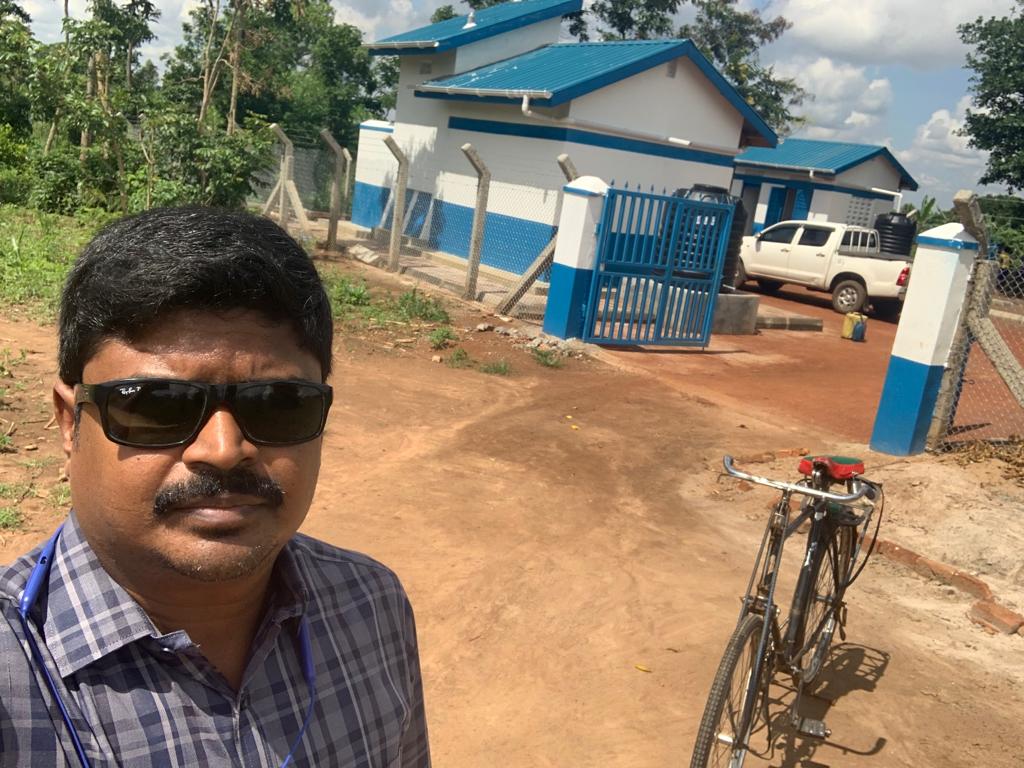A water distribution system is a part of water supply network with components that carry potable water from a centralized treatment plant or wells to consumers to satisfy residential, commercial, industrial and fire fighting requirements.[3][4]
Definitions
Water distribution network is the term for the portion of a water distribution system up to the service points of bulk water consumers or demand nodes where many consumers are lumped together.[5] The World Health Organization (WHO) uses the term water transmission system for a network of pipes, generally in a tree-like structure, that is used to convey water from water treatment plants to service reservoirs, and uses the term water distribution system for a network of pipes that generally has a loop structure to supply water from the service reservoirs and balancing reservoirs to consumers.[6]
Components

A water distribution system consists of pipelines, storage facilities, pumps, and other accessories.[7]
Pipelines laid within public right of way called water mains are used to transport water within a distribution system. Large diameter water mains called primary feeders are used to connect between water treatment plants and service areas. Secondary feeders are connected between primary feeders and distributors. Distributors are water mains that are located near the water users, which also supply water to individual fire hydrants.[8] A service line is a small diameter pipe used to connect from a water main through a small tap to a water meter at user’s location. There is a service valve (also known as curb stop) on the service line located near street curb to shut off water to the user’s location.[9]
Storage facilities, or distribution reservoirs, provide clean drinking water storage (after required water treatment process) to ensure the system has enough water to service in response to fluctuating demands (service reservoirs), or to equalize the operating pressure (balancing reservoirs). They can also be temporarily used to serve fire fighting demands during a power outage. The following are types of distribution reservoirs:
- Underground storage reservoir or covered finished water reservoir: An underground storage facility or large ground-excavated reservoir that is fully covered. The walls and the bottom of these reservoirs may be lined with impermeable materials to prevent ground water intrusion.[10]
- Uncovered finished water reservoir: A large ground-excavated reservoir that has adequate measures or lining to prevent surface water runoff and ground water intrusion but does not have a top cover. This type of reservoir is less desirable as the water will not be further treated before distribution and is susceptible to contaminants such as bird waste, animal and human activities, algal bloom, and airborne deposition.[10]
- Surface reservoir (also known as ground storage tank and ground storage reservoir): A storage facility built on the ground with the wall lined with concrete, shotcrete, asphalt, or membrane. A surface reservoir is usually covered to prevent contamination. They are typically located in high elevation areas that have enough hydraulic head for distribution. When a surface reservoir at ground level cannot provide a sufficient hydraulic head to the distribution system, booster pumps will be required.[4][11]
- Water tower (also known as elevated surface reservoir): An elevated water tank. A few common types are spheroid elevated storage tank, a steel spheroid tank on top of a small-diameter steel column; composite elevated storage tank, a steel tank on a large-diameter concrete column; and hydropillar elevated storage tanks, a steel tank on a large-diameter steel column. The space within the large column below the water tank can be used for other purposes such as multi-story office space and storage space. A main concern for using water towers in the water distribution system is the aesthetic of the area.[11][12]
- Standpipe: A water tank that is a combination of ground storage tank and water tower. It is slightly different from an elevated water tower in that the standpipe allows water storage from the ground level to the top of the tank. The bottom storage area is called supporting storage, and the upper part which would be at the similar height of an elevated water tower is called useful storage.[4]
- Sump: This is a contingency water storage facility that is not used to distribute water directly. It is typically built underground in a circular shape with a dome top above ground. The water from a sump will be pumped to a service reservoir when it is needed.[12]
Storage facilities are typically located at the center of the service locations. Being at the central location reduces the length of the water mains to the services locations. This reduces the friction loss when water is transported over a water main.[4]









<script async src="https://pagead2.googlesyndication.com/pagead/js/adsbygoogle.js?client=ca-pub-5985638744296477"
crossorigin="anonymous"></script>
